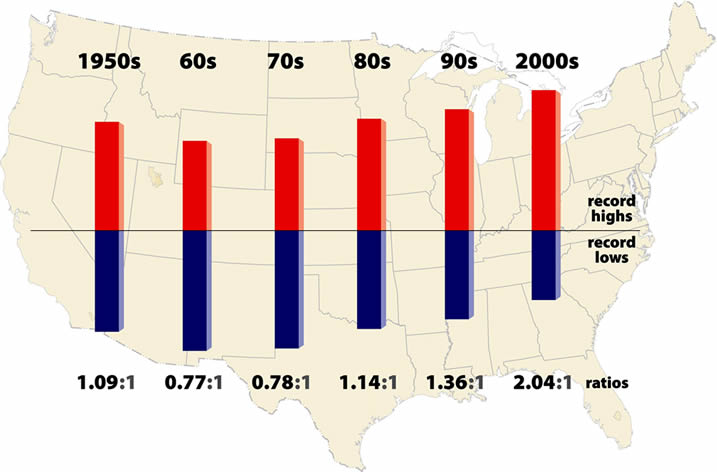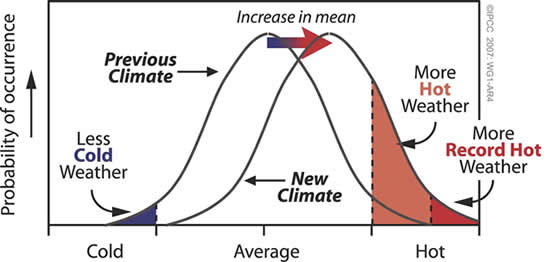
|
||||||||||||
|
|
|
Current Extreme Weather & Climate Change September 2011 Climate Communication-Recent weather events such as deadly heat waves and devastating floods have sparked popular interest in understanding the role of global warming in driving extreme weather. These events are part of a new pattern of more extreme weather across the globe, shaped in part by human-induced climate change. As the climate has warmed, some types of extreme weather have become more frequent and severe in recent decades, with increases in extreme heat, intense precipitation, and drought. Heat waves are longer and hotter. Heavy rains and flooding are more frequent. In a wide swing between extremes, drought, too, is more intense and more widespread. All weather events are now influenced by climate change because all weather now develops in a different environment than before. While natural variability continues to play a key role in extreme weather, climate change has shifted the odds and changed the natural limits, making certain types of extreme weather more frequent and more intense. The kinds of extreme weather events that would be expected to occur more often in a warming world are indeed increasing. For example, 60 years ago in the continental United States, the number of new record high temperatures recorded around the country each year was roughly equal to the number of new record lows. Now, the number of new record highs recorded each year is twice the number of new record lows, a signature of a warming climate, and a clear example of its impact on extreme weather.
The increase in record highs extends outside the U.S. as well. A similar two to one ratio of record highs to record lows recently has been observed in Australia. Over the past decade, 75 counties set all-time record highs but only 15 countries set all-time record lows. In 2010, 19 countries set new all-time record high temperatures, but not a single country set a new all-time record low (among those countries keeping these statistics).
One way in which climate change is connected to individual events such as heat waves and heavy rains is by increasing the odds they will occur. We witness that connection in the form of more frequent extreme events. Analyzing how global warming has changed the odds for a specific event has been done for standout moments such as the European heat wave of 2003 that killed tens of thousands. Based on temperature records from 1864 to 2002, the odds of such a heatwave occurring are about 1 in 10 million . An event like the 2003 heatwave becomes much more likely after factoring in the observed warming of 2°F over Europe and increased weather variability. In addition, comparing computer models of climate with and without human contribution shows that human influence has roughly quadrupled the odds of a European summer as hot as or hotter than the summer of 2003. A Small Increase in Average Temperature Leads to Big Changes in Extreme Weather
Small changes in the averages of many key climate variables can correspond to large changes in weather. Substantial changes in the frequency and intensity of extreme events can result from a relatively small shift in the average of a distribution of temperatures, precipitation, or other climate variables Weather variation on our planet can be described with a rough bell-shaped curve. So-called normal weather is very common while extreme weather is rare. While events close to normal occur frequently, in the broad center of the curve, there is a sharp fall-off in the frequency of events further away from normal, in the flatter ends of the curve. For instance, a small increase in temperature shifts the entire curve toward hotter high temperatures. The rarest and most extreme record heat events become even more severe and much more frequent. Precipitation does not follow quite the same pattern, but the same concept applies: fewer light and moderate rains are being replaced by more heavy rain events. While our understanding of how climate change affects extreme weather is still developing, evidence suggests that extreme weather may be affected even more than anticipated. Changes in precipitation are quite complex, and current computer models of climate have only a limited ability to predict the heaviest precipitation. Recent observed changes in precipitation have been even greater than the changes projected by climate models. Even with their limitations, current models still capture the physical processes associated with the observed increases in intense precipitation. Warmer air holds more moisture. That additional moisture fuels increases in precipitation intensity. This has been been measured in real-world observations as well as simulated by climate models. Humans Contribute to Extreme Weather – and Suffer its Consequences Rigorous analyses have shown that natural variability alone cannot explain the observed long-term trends of changing extremes in temperature and precipitation. In contrast, the observed trends fit well with our understanding of how climate change drives changes in weather. Computer models of the climate that include both natural forces as well as human influences are consistent with observed global trends in heat waves, warm days and nights, and frost days over the last four decades. Human influence has also been shown to have contributed to the increase of heavy precipitation over the Northern Hemisphere. Extreme weather events do not have a single cause but instead have various possible contributing factors – and human-induced climate change is now one of those factors. Weather variability can be extremely costly. One estimate finds that the total U.S. economic output varies by up to $485 billion/year owing to weather variability. From 1980 to 2010 there were 99 weather disasters in the U.S. in which damages exceeded $1 billion. Altogether those disasters cost $725 billion. In 2011, the costs of all weather-disaster damages so far has climbed past $35 billion, according to NOAA estimates. As of August 30th, the U.S. has witnessed 10 weather disasters costing over $1 billion each. This breaks the previous record for the number of such U.S. weather disasters in an entire year. Changes in extreme weather threaten human health as well as prosperity. Many societies have taken measures to cope with historical weather extremes, but new, more intense extremes have the potential to overwhelm existing human systems and structures. More frequent and more severe extreme weather events are more likely to destabilize ecosystems and cripple essential components of human livelihood, such as food production, transportation infrastructure, and water management. Death, disease, displacement, and economic hardship may follow, as we have seen with recent hurricanes, floods, heat waves, and droughts.
Climate Communication is a non-profit science and outreach project funded by the Rockefeller Brothers Fund and the ClimateWorks Foundation. Climate Communication operates as a project of the Aspen Global Change Institute, a non-profit organization dedicated to furthering the scientific understanding of Earth systems and global environmental change. |




